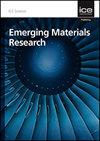用于CO2转化的Cu2O/PANI/Si基光电阴极的光电化学性能
IF 1.2
4区 材料科学
Q4 MATERIALS SCIENCE, MULTIDISCIPLINARY
引用次数: 1
摘要
目前的研究旨在将二氧化碳转化为甲醇等增值产品,这不仅可以解决控制大气中二氧化碳浓度水平的潜在解决方案,而且可以为生产可再生能源提供另一种方法。为此,本文合成了多种杂化光电催化剂,对其进行了表征,并将其作为光电阴极,在可见光照射下在水介质中进行了CO2光催化还原制甲醇的研究。研究了用氧化铜(Cu2O)颗粒敏化或不敏化聚苯胺(PANI)覆盖的平面硅(Siflat)和锥体织构硅(SiPY)衬底。结果表明,聚苯胺与Cu2O的结合提高了光电阴极表面对CO2的化学吸附能力,同时也促进了光生电子-空穴(e−/h+)对的分离,大大提高了光电阴极对CO2还原为甲醇的效率。PEC结果表明,外加电位对光电流稳定性有影响。Cu2O敏化能有效分离光生成的e−/h+对,从而提高了杂化光催化剂的PEC CO2还原活性。以Cu2O/PANI/SiPY异质结构为光电阴极,在- 1.2V vs SCE电位下,制备甲醇的最佳法拉第效率达到57.66%。本文章由计算机程序翻译,如有差异,请以英文原文为准。
Photoelectrochemical properties of Cu2O/PANI/Si-based photocathodes destined for CO2 conversion
The present study was aimed to convert CO2 into value-added products such as methanol which not only could address the potential solution for controlling the CO2 concentration level in the atmosphere but also can offer an alternative approach for the production of renewable energy sources. In this perspective, various hybrid photoelectrocatalysts were synthesized, characterized and used as photocathodes for photoelectrocatalytic (PEC) reduction of CO2 to methanol in aqueous medium under visible light irradiation. Flat silicon (Siflat) and pyramidal textured silicon (SiPY) substrates, covered with polyaniline (PANI) with or without sensitization with copper oxide (Cu2O) particles were investigated. It was noticed that the combination of PANI and Cu2O greatly increased the PEC CO2 reduction to methanol owing to enhance the CO2 chemisorption capacity by the photocathode surface and at the same time facilitated the separation of photogenerated electron-hole (e−/h+) pairs. The PEC results demonstrated that the applied potential impacts the photocurrent stability. The sensitization with Cu2O effectively separate the photogenerated e−/h+ pairs and therefore, enhanced the PEC CO2 reduction activity of the hybrid photocatalyst. The best Faradaic efficiency (FE) for methanol formation reached 57.66 % which was recorded when Cu2O/PANI/SiPY heterostructure was used as photocathode at applied potential of −1.2V vs SCE.
求助全文
通过发布文献求助,成功后即可免费获取论文全文。
去求助
来源期刊

Emerging Materials Research
MATERIALS SCIENCE, MULTIDISCIPLINARY-
CiteScore
4.50
自引率
9.10%
发文量
62
期刊介绍:
Materials Research is constantly evolving and correlations between process, structure, properties and performance which are application specific require expert understanding at the macro-, micro- and nano-scale. The ability to intelligently manipulate material properties and tailor them for desired applications is of constant interest and challenge within universities, national labs and industry.
 求助内容:
求助内容: 应助结果提醒方式:
应助结果提醒方式:


